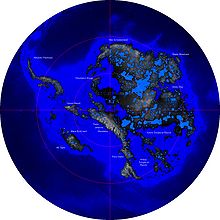



The geology of Antarctica covers the geological development of the continent through the Archean, Proterozoic and Phanerozoic eons.
The geological study of Antarctica has been greatly hindered by the fact that nearly all of the continent is continuously covered with a thick layer of ice. However, techniques such as remote sensing have begun to reveal the structures beneath the ice.
Geologically, West Antarctica closely resembles the Andes of South America.[1][page needed] The Antarctic Peninsula was formed by uplift and metamorphism of sea-bed sediments during the late Paleozoic and the early Mesozoic eras. This sediment uplift was accompanied by igneous intrusions and volcanism. The most common rocks in West Antarctica are andesite and rhyolite volcanics formed during the Jurassic Period. There is also evidence of volcanic activity, even after the ice sheet had formed, in Marie Byrd Land and Alexander Island. The only anomalous area of West Antarctica is the Ellsworth Mountains region, where the stratigraphy is more similar to the eastern part of the continent.
The West Antarctic Rift System, a major active rift valley, lies between West and East Antarctica. Its major phase of rapid, broad extension occurred in Cretaceous time, and involved the action of both normal and strike slip faults within West Antarctica and contiguous Zealandia.[2] The rift is still active with slow movement of West Antarctica away from East Antarctica.[3]
East Antarctica is geologically very old, dating from the Precambrian, with some rocks formed more than 3 billion years ago. It is composed of a metamorphic and igneous platform which is the basis of the continental shield. On top of this base are various more modern rocks, such as sandstones, limestones, coal and shales laid down during the Devonian and Jurassic periods to form the Transantarctic Mountains. In coastal areas such as Shackleton Range and Victoria Land some faulting has occurred.
More than 170 million years ago, Antarctica was part of the supercontinent Gondwana. Over time Gondwana broke apart and Antarctica as we know it today was formed around 35 million years ago.